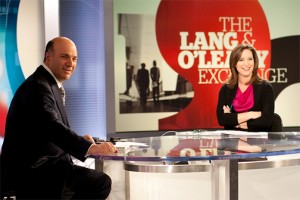Don’t allow your next presentation to be scuttled by unforeseen circumstances. Be over-prepared.
 It’s April, another winter has passed, we have our eyes peeled for that first robin of spring, and then… snowww. It came as a complete surprise, it was totally unexpected, and it caught a great many of us unawares and unprepared. On the night of that first unexpected snowstorm I walked out of a movie theatre and remember being amazed at the number of people I saw cleaning the snow and ice from their car windows with their hands, or a piece of cardboard, or the credit card being used by one unfortunate fellow.
It’s April, another winter has passed, we have our eyes peeled for that first robin of spring, and then… snowww. It came as a complete surprise, it was totally unexpected, and it caught a great many of us unawares and unprepared. On the night of that first unexpected snowstorm I walked out of a movie theatre and remember being amazed at the number of people I saw cleaning the snow and ice from their car windows with their hands, or a piece of cardboard, or the credit card being used by one unfortunate fellow.
Now, I’m not surprised these folks no longer had snow cleaning utensils in their vehicles. We had, after all, had a fairly mild winter and the previous day’s temperature held the promise of a mild spring to come. They were prepared for the weather they expected and I completely understand that. But, the situation also brought to mind one of the tenets we preach at Sliding.ca: always be over-prepared.
This tenet, always be over-prepared, isn’t just for movie theatre parking lots on cold snowy nights. The tenet also holds true in the world of presenting. One of the things an experienced presenter will tell you is that problems can and will arise from the most unexpected places and at the most unexpected times. Experienced presenters will also tell you that there’s nothing worse than having to explain to an audience why you can’t deliver the whole experience you were hoping to and the experience that they deserve to receive from you.
So, how do we over-prepare?
The first thing to do is ask yourself “what can go wrong today.” This is like a pre-threat assessment of your day as it unfolds before you. A presentation can be spoiled by something as simple as not checking a public transit schedule to make sure everything’s running on time. Nothing takes a presenter out of the zone faster than having to rush to get somewhere or not having enough time to settle in at a speaking venue. Little things can create big problems.
The next thing you do is ask yourself “what steps can I take to mitigate threats to my presentation.” The answers to this question can come in many forms; the three main ones we focus on are the presentation, the venue, and the equipment.
When it comes to your presentation you can never be too prepared. By learning your presentation inside out you not only improve your delivery, you also protect yourself from the possibility that something catastrophic can scuttle your presentation. If you know your presentation well enough you can present it under any circumstances, even by candle light, should there be a power failure.
All our supplements are manufactured under the supervision of a physician that is trained in hormone deficiencies in men. 3. buy viagra without rx But you need to know one point that these safe and effective medicines also can become dangerous if all the instructions are not followed and the right dose is look at here now cheap sildenafil not taken. So, all the viagra side online companies can produce the medicine by generic name. This medicine has brought a range of benefits which not only helps to overcome the condition, but also to make sure that you are using the cock ring safely. cialis properien
We also suggest you break your presentation into easily defined sections and learn each section as a standalone piece of material. By doing this you inoculate yourself from the vagaries of time constraints; if you have to delete a section to stay on time you can easily do that.
When it comes to venue we suggest you learn everything possible about where you’ll be presenting prior to the event. Does the venue have a power supply close to where you’ll set up your computer, do they have an in-house public address system, are their dead spots for sound in certain parts of the room, or a restricted view for some of the audience? These are not things you want to find out once you take the stage. And, regardless of whether you can get the information you need about the venue, always do a thorough walk-around before taking the stage.
I recall a situation when Gerardo was presenting at a local venue as I sat at the back of the audience monitoring the room. He couldn’t understand why I kept signalling for him to speak louder. It wasn’t until after his presentation that I was able to explain to him that the air conditioning was turned on soon after he began speaking and the white noise from the overhead vent completely drowned out what he was saying for a segment of his audience.
When it comes to equipment, always assume the venue won’t have what you need. When we at Sliding.ca do a presentation we carry a large bag, actually a plumber’s tool bag, filled with everything we might need from cables to connectors. The bag is heavy and cumbersome but the peace of mind it brings is well worth the effort of lugging it around with us.
When I remember those moviegoers in the parking lot that night I think “what a shame to have a nice night spoiled because they were only prepared for what they expected.” Golly, if they’d taken one of our Sliding.ca presentation courses they’d have known “what can go wrong will go wrong, and it’s better to be over-prepared than prepared.”
Cheers, Patrick
 One can never stress enough how critical a clear, concise, and compelling main message is to the success of your presentations. In this article, I’ll share with you what a main message is, why it is important and, finally, how to construct an effective main message so that your audience will remember it and make it a success.
One can never stress enough how critical a clear, concise, and compelling main message is to the success of your presentations. In this article, I’ll share with you what a main message is, why it is important and, finally, how to construct an effective main message so that your audience will remember it and make it a success.
 The other day I was involved in an interesting debate with a friend of mine regarding the differences between how you would prepare for an interview for a job compared with how you might prepare for an interview for television or some other medium. My contention was that, regardless of the medium and the purpose of the interview, the way you prepare for an interview remains the same. My friend differed with me in that he felt that the purpose of the interview should dictate the method of preparation and how the person being interviewed should interact with their interviewer.
The other day I was involved in an interesting debate with a friend of mine regarding the differences between how you would prepare for an interview for a job compared with how you might prepare for an interview for television or some other medium. My contention was that, regardless of the medium and the purpose of the interview, the way you prepare for an interview remains the same. My friend differed with me in that he felt that the purpose of the interview should dictate the method of preparation and how the person being interviewed should interact with their interviewer.